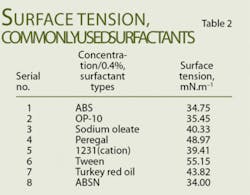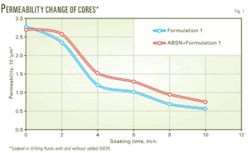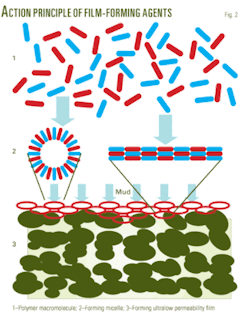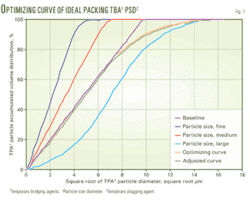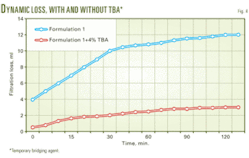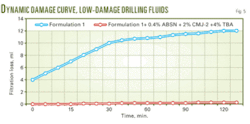New drilling fluids prevent formation damage in a sandstone reservoir in northwest China’s Turpan Hami (Tuha) basin. The Tuha oil field is the only integrated condensate-gas field development in the Turpan Hami Oil field Branch, Shanshan, Xinjiang Uygur autonomous region of China.
Low-permeability, dense reservoirs are commonly characterized by a high content of clays, high original water saturation, high sensitivity to invasive fluids, high capillary pressure, complicated structure and anisotropic, and high flow-resistance.
Generally, these reservoirs also contain numerous natural microfractures, probably leading to stress sensibility. This article reviews the geological characteristics and potential damage in the Tuha sandstone, a dense Jurassic reservoir, and introduces a new, multifunctional drilling fluid system.
The fluid includes preventive, water-blocking surfactants and consists mainly of amphion polymer, sulfonation polymer, ideal packing temporary bridging agents (TBA), and film-forming agents.
We include a systematic analysis of the main damage mechanisms and factors influencing water-blocking. Numerous studies have shown that the extent of water-blocking ranges from 70% to 90%.1-5 Once damaged, reservoirs can rarely be recovered.
Researchers at China University of Petroleum in Beijing experimentally evaluated the rheological properties, inhibition, compatibility, and regained permeability of the new fluid. Both lab evaluations and field tests show that the new amphion, sulfonation polymer drilling fluid is suitable for low-permeability dense gas reservoirs in China’s Tuha oil field.
Geological characteristics
In the oil-producing, Jurassic, Qiudong formation, the main lithology is fine sand. Porosity ranges from 11.9% to 13.5%; permeability ranges from 0.08 × 10–3 µm2 to 13.6 × 10–3 µm2; and radii of pore throats range from 0.1 to 1.0 µm (average 0.28 µm). Most of the rock has microfine pore throats along with many micro fractures; this plays a leading role in seepage flow and reduces or eliminates storage capacity.
In short, the target formation can be characterized as a typical low-permeability, dense formation with microporosity. Hydraulic fracturing is the main method for enhancing oil-gas recovery during production operations.
Potential damage
Based on geological characteristics and lab evaluation, the main damaging factors and existing problems can be summarized as follows:
- Sensibility evaluation of cores taken from well QD3 (depth 3,105.0-3,141.5 m) show that main damaging factors are moderately high flow rate, light salt, acid, and alkali sensibility.
- Permeability and skin factor are high before and after wells are put into production, indicating that the formation was contaminated early. In well QD3, for instance, the early permeability was 1.45 × 10–3µm2 and the skin factor was 25.4. After 20 days, the permeability increased to 2.93 × 10–3µm2 and the skin factor decreased to 19.6. This type of damage will not be eliminated during production.
- For permeability recovery of wellsite drilling fluids, early experimental result was 56.6%; after 20 days, it was 51.4%. Generally speaking, however, permeability recovery of fluids is less than 70%.
Multifunctional drilling fluids
The first step in systemic formation protection is to prevent formation damage during drilling operations.
At first, formations are exposed to drilling fluids, sometimes over a prolonged period because of well depth, circulation loss, drill pipe sticking, and well collapse. Consequently, invasive fluids induce water sensibility and water blocking, resulting in extensive damage.
Therefore, drilling fluids should have good properties including strong inhibition, low filtration, water-blocking prevention, and suitable density for near-balance to underbalanced drilling operations.
Based on current drilling technology and known damage factors in low-permeability Jurassic formations, guidelines to develop new drilling fluids include:
- Selecting effective surfactants to minimize water-blocking caused by filtration.
- Adopting three kinds of amphion polymer with different molecular weights to substitute for macromolecule polymer KPAM.
- Selecting compound TBAs by adopting ideal packing theory (IPT) to form a thinner, tighter mud cake and achieve a good temporary plugging effect.6 7
- Selecting film-forming agents to further improve inhibition of drilling fluids.8
The final formulation of drilling fluids formed by these guidelines should have good rheological properties and be compatible with the characteristics of the target formation, as well remain in a safe density window during drilling operations.
Optimizing basic formulation
We used amphion polymer, FA-367, JT-888 and XY-27 as the main additives to the drilling fluid and determined their concentration by using an orthogonal experimental method (L934).
We optimized the basic drilling fluid formulation (Formulation 1) as follows: 3% bentonite + 0.3% FA-367 + 0.6% JT-888 + 0.1% XY-27 + 1.5% SMP-1 + 1.5% SPNH.
Table 1 shows the rheological parameters. Experimental results show that we achieved relatively reasonable rheological properties.
The next step was to minimize API and HTHP filtration through technology of film-forming and ideal packing TBA.
Selecting surfactants
Young-Laplace’s equation8 and D.B. Bennion’s prediction formula have shown that water-blocking damage is mainly related to core permeability, porosity, initial water saturation, and oil-gas interface tension. It is also related to the lithological characteristics of the formation, types of cementation, porosity structure, and properties of invasive fluids.
Effective surfactants can markedly minimize surface tension and oil-gas interfacial tension of filtration. We tested the surface tension of eight commonly used surfactants (Table 2; OGJ, May 19, 2008, p. 45).
Experimental results show that ABSN and OP-10 can effectively reduce surface tension and these were recommended as preventive water-blocking agents in drilling fluids. ABSN may form precipitates when the concentration of Ca2+ is high in formation brine. In this case, OP-10 can be substituted. The concentration of both surfactants should not exceed 0.4%.
We used cores taken from well QD3 (depth 3,105.0-3,141.5 m) and soaked them in drilling fluids (Formulation 1), with and without added 0.4% ABSN, for different lengths of time. We then measured the core permeability at displacement differential pressure of 0.4 MPa. Fig. 1 shows experimental results.
The results show that the permeability of cores soaked in drilling fluids with added 0.4% ABSN was relatively higher and the reduction in permeability was postponed, suggesting that adding ABSN to drilling fluids can effectively minimize the extent of water-blocking.
Selecting film-forming agents
Ultralow permeability drilling fluids composed of special polymers can form supermolecules and deposit a plugging film on the wellbore rock surface. This will pack pore throats and effectively prevent filtrates from entering the formation.9 Fig. 2 illustrates the action principle of film-forming agents.
Film-forming technology depends predominantly on ultralow permeability film-forming agents. We selected FLC2000 and CMJ-2, for lab optimizing experiments. These two agents consist primarily of plant derivatives and water-soluble organic polymer and metal oxide compounds. They have relatively high temperature stability, are simple to maintain, and produce little environmental contamination.
Impact on drilling fluids
We added the two different film-forming agents to drilling fluids (Formulation 1) for 24 hr, let sit at 120° C. for 16 hr, then measured rheological properties (Table 3). The results indicate that relatively lower filtration can be achieved after adding the film-forming agents, with little impact on rheological parameters of drilling fluids.
null
Filtration tests
In dynamic filtration tests, we simulated cores with rust-free steel slot plates (50 µm wide). The plates were set up in clamps of high-pressure, high temperature (HPHT) filtration apparatus and measured filtration change of drilling fluids over time at 90° C. (Table 4). Experimental data show that initial loss and total loss are nearly zero filtration.
Considering cost and transportation factors, we recommend a 2% concentration of CMJ-2 as the preferred film-forming agent in drilling fluids.
Selecting TBAs
Based on the relationship between the particle-size distribution of temporary bridging agents and size distribution of pore throats, we determined the D90 (largest pore throat) of TBA using the ideal packing theory (IPT) and the D90 rule.7 We used corresponding matching software, considered shearing and abrasion of TBA in the annulus between drillstring and wellbore. Finally, we determined the ideal packing composition for a calcium carbonate-based TBA: 600 mesh (10%); 800 mesh (40%); 1,000 mesh (50%), as shown in Fig. 3.
null
null
We measured rheological parameters and dynamic loss of drilling fluids after adding the optimized TBA (Fig. 4, Table 5). The rheological parameters are reasonable and filtration is further reduced. The total loss falls to 4 ml from 12 ml. The initial instantaneous loss fell dramatically, illustrating that the introduction of the optimized TBA helped to protect the formation. We recommend a 4% concentration of this TBA in drilling fluids.
Formulation 2
Based on the optimized results, the new low-damage drilling fluids system (Formulation 2) is: 3% bentonite + 0.3% FA-367 + 0.6% JT-888 + 0.1% XY-27 + 1.5% SMP-1 + 1.5% SPNH + 0.4% ABSN + 2% CMJ-2 + 4% ideal packing TBA. Adding 0.5-1% oil-soluble resin can further improve temporary bridging effect.
Rheology
We evaluated the rheological properties of drilling fluids with and without weighting with BaSO4 (Table 6). The experimental results indicate that the new drilling fluids system has good high-temperature stability. The API and HPHT loss is less than 5 ml (without BaSO4) and 10 ml (with BaSO4) and the frictional coefficient is less than 0.141. The lubrication and inhibition properties meet the requirements of drill-in fluids for low-permeability formations.
null
Compatibility with formation
To determine the compatibility of the new drilling fluids with formation rocks and fluids, we mixed 6-10 mesh rock cuttings with new drilling fluids, aged at 120° C. for 16 hr, then measured rock cuttings recovery. More than 99% was recovered after screening through 40 mesh, illustrating that the new drilling fluids have good compatibility with formation rock. Shape and size of rock cuttings exhibited no obvious change during above experiments.
We also mixed the drilling fluids with simulated formation brine in different proportions. There was no flocculation, chemical reaction, or precipitate formed, indicating good compatibility with formation brine.
Evaluating formation damage
We used a JHMF-2 dynamic damage experimental apparatus to examine cores taken from low-permeability target formation in well QD-3 (depth interval 3,105.0-3,141.5 m).
The experiment took place at simulated wellsite formation conditions, at a temperature of 90° C., contaminated differential pressure of 3.5 MPa, and shearing rate of 150 s–1. Table 7 shows the experimental results.
Experimental results illustrated in Fig. 5 show that dynamic permeability recovery clearly improved and can reach 82.8% and 81.0%, respectively (wellsite drilling fluids formulation are 56.6% and 51.4%, respectively). After adding optimizing film-forming and ideal packing TBA to drilling fluids, the dynamic loss is low, initial fluid loss is nearly zero, and we achieved a good film-forming effect.
Results
Water blocking is the main damaging factor for low-permeability reservoirs, reducing permeability by 70% to 90%. Once damaged, formation permeability can rarely be recovered. Low-permeability formations with low pressure can be even more severely affected.
Main factors that cause water blocking include: core permeability, porosity, original water saturation, and oil-water interfacial tension, as well as lithology characteristics, types and content of cementing substances, pore structure, and properties of invasion fluids.
New drilling fluids devised to cause minimal damage consist of ideal packing temporary bridging agents, film-forming agents, and water-blocking prevention surfactants. These fluids have many advantages over fluids used previously, including good compatibility with target formations, high permeability recovery, low filtration (nearly zero loss), small friction coefficient, and reasonable rheological parameters.
The new fluids prevent water-blocking, provide a good temporary plugging effect, and have ultralow permeability (API filtration =5 ml, HTHP filtration =10 ml, mud cake frictional coefficient =0.14, permeability recovery >81%). These fluids efficiently prevent or minimize damage, preserve natural formation characteristics, and enhance comprehensive development-investment effect in Tuha sandstone, a dense, Jurassic reservoir with low permeability.
References
- Lin, Guang-Rong, Shao, Chuang-Guo, Xu, Zheng-Feng, et al., “Fluid damage and solution method study of low permeability gas reservoir,” Journal Petroleum Exploration and Development, 2003, Vol. 30, No. 6, pp. 117-118.
- Ren, Xiao-Juan, Zhang, Ning-Sheng, Zhang, Xi-Feng, et al., “Damage of residual water on permeability of tight gas reservoir,” Journal Natural Gas Industry, 2004, Vol. 24 No. 11, pp. 106-108.
- Bennion, D.B., Thomas, F.B., and Ma, T., “Formation Damage Processes Reducing Productivity of Low Permeability Gas Reservoirs,” SPE Rocky Mountain Regional/Low-Permeability Reservoirs Symposium and Exhibition, Mar. 12-15, 2000, Denver, SPE 60325.
- Erwin, M.D., Pierson, C.R., and Bennion, D.B., “Brine Imhibition Damage in the Colville River Field, Alaska,” SPE Annual Technical Conference and Exhibition in Denver, Oct. 5-8, 2003, SPE 84320.
- Bennion, D.B., Thomas, F.B., Bietz, R.F., et al., “Remediation of Atr and Hydrocarbon Phase Trapping Problems in Low Permeability Gas Reservoirs,” Journal of Canadian Petroleum Technology, 1999, Vol. 38, No. 8.
- Yan, Jienan, and Feng, Weng, Qiang, “Design of Drill-in Fluids by Optimizing Selection of Bridging Particles,” SPE China International Oil & Gas Conference, December 5-7, 2006, Beijing, SPE 104131.
- Vickers, Stephen, Cowie, Martin, Jones, Tom, Twynam, Allan J., “A new methodology that surpasses current bridging theories to efficiently seal a varied pore throat distribution as found in natural reservoir formations,” AADE-06-DF-HO-16, AADE 2006 Fluids Conference, Houston, Apr. 11-12, 2006.
- Pu, Xiao-lin, Lei, Gang, Luo, Xing-shu, et al., “Study on membrane theory and film-forming drilling fluid,” Journal Drilling fluid and Completion Fluid, 2005, Vol. 22, No. 6, pp. 1-4.
- Cui, Ying-Chun, Zhang, Yan, “Characteristics of formation damage in low permeability reservoir,” Journal Drilling Fluid and Completion Fluid, 1998, Vol. 15, No. 2, pp. 11-13.
The authors
Yong Shu ([email protected]) is a senior engineer and PhD student at the MOE Key Laboratory of Petroleum Engineering in the department of oil and gas engineering, China University of Petroleum (Beijing). His current research interests include damage during drilling and production of low-permeability oil and gas fields. Shu holds a BS (1997) in petroleum engineering from China University of Petroleum (East China).
Jienian Yan ([email protected]) is a professor and doctoral-student supervisor at the MOE Key Laboratory of Petroleum Engineering in the department of oil and gas engineering, China University of Petroleum (Beijing). His research interests focus on drilling fluids, borehole stability, formation damage control, etc. Yan holds a BS (1968) in chemistry from Beijing Normal University and an MS (1981) in petroleum engineering from Southwest Petroleum University, Chengdu, China. He was a visiting scholar in the department of petroleum egineering, University of Texas at Austin (1986-88), and a visiting professor at the department of petroleum and chemical engineering, University of Wyoming (1995). Yan is a member of SPE.


